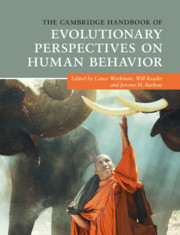Book contents
- The Cambridge Handbook of Evolutionary Perspectives on Human Behavior
- The Cambridge Handbook of Evolutionary Perspectives on Human Behavior
- Copyright page
- Dedication
- Contents
- Figures
- Tables
- Contributors
- Preface
- Acknowledgments
- Part I The Comparative Approach
- Part II Sociocultural Anthropology and Evolution
- 4 Eusociality in Humans
- 5 The Nature and Psychological Foundation of Social Universals
- 6 The Study of Culture and Evolution across Disciplines
- Part III Evolution and Neuroscience
- Part IV Group Living
- Part V Evolution and Cognition
- Part VI Evolution and Development
- Part VII Sexual Selection and Human Sex Differences
- Part VIII Abnormal Behavior and Evolutionary Psychopathology
- Part IX Applying Evolutionary Principles
- Part X Evolution and the Media
- Index
- References
6 - The Study of Culture and Evolution across Disciplines
from Part II - Sociocultural Anthropology and Evolution
Published online by Cambridge University Press: 02 March 2020
- The Cambridge Handbook of Evolutionary Perspectives on Human Behavior
- The Cambridge Handbook of Evolutionary Perspectives on Human Behavior
- Copyright page
- Dedication
- Contents
- Figures
- Tables
- Contributors
- Preface
- Acknowledgments
- Part I The Comparative Approach
- Part II Sociocultural Anthropology and Evolution
- 4 Eusociality in Humans
- 5 The Nature and Psychological Foundation of Social Universals
- 6 The Study of Culture and Evolution across Disciplines
- Part III Evolution and Neuroscience
- Part IV Group Living
- Part V Evolution and Cognition
- Part VI Evolution and Development
- Part VII Sexual Selection and Human Sex Differences
- Part VIII Abnormal Behavior and Evolutionary Psychopathology
- Part IX Applying Evolutionary Principles
- Part X Evolution and the Media
- Index
- References
Summary
Evolutionary scholars often appear to disagree strikingly about the value of “culture” in explaining human behavior. John Tooby, one of the founders and figureheads of evolutionary psychology, recently responded to the Edge.org question “What scientific idea is ready for retirement?” with the answer “Learning and culture” (Tooby, 2014). At around the same time, Joseph Henrich, Professor of Human Evolutionary Biology at Harvard, published a book titled The Secret of Our Success: How Culture Is Driving Human Evolution, Domesticating Our Species, and Making Us Smarter (Henrich, 2015). How can two highly reputable scholars, both committed to understanding human behavior within an evolutionary framework, come to such apparently opposing conclusions? Should the concept of “culture” be retired, or should it be heralded as the secret to humanity’s evolutionary success?
- Type
- Chapter
- Information
- Publisher: Cambridge University PressPrint publication year: 2020
References
- 4
- Cited by

